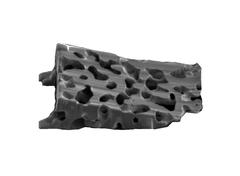URL: https://www.desy.de/news/news_search/index_eng.html
Breadcrumb Navigation
DESY News: Live view into catalyst materials
News
News from the DESY research centre
Live view into catalyst materials
A new X-ray study offers unprecedented possibilities for analysing catalysts and other materials with a porous structure. The work marks an important step towards tailor-made porous materials and can thus contribute to saving emissions and raw materials in a more sustainable chemistry, as the team led by Thomas Sheppard from the Karlsruhe Institute of Technology (KIT) reports in the journal Advanced Science. Researchers from the Paul Scherrer Institute in Switzerland, the MAX IV research centre in Sweden, the universities of Hamburg and Leipzig, KIT and DESY are involved in the study.

Typical structure of a porous catalyst material. Credit: KIT, Sebastian Weber
In addition to the large surface area, the diameter of the pores and their interconnection into a larger network have a decisive role on the physicochemical properties of the material. In particular the pore network controls the transport of molecules within the pore system, which is referred to as mass transport. The mass transport properties of a catalyst are crucial for its performance and an important design parameter in the search for better catalysts, especially in industrial applications. As the majority of all industrial chemical processes involve a catalyst at some stage during production, already small improvements in efficiency have a big influence on, e.g., the required process energy and linked CO2 emissions, or the formation of undesired secondary products. Therefore, the optimization of the pore structure can provide an important contribution to more sustainable chemical synthesis and processes.
However, the preparation of materials with adapted pore structures often requires complex synthesis methods, which are often based on experience and ‘trial and error’ approaches, and are in general not fully understood. Additionally, changes of the pore structure under reaction conditions can usually only be studied in comparison to the initial and final state, but not during the reaction as the material performs its chemical function. However, to optimize the pore system in a knowledge-based way, it is important to gain access to information of the changes during synthesis or reaction, which is currently limited by conventional and established methods.
The use of modern hard X-ray microscopy methods at synchrotron radiation sources like DESY's PETRA III is one such method to study complex pore structures, which typically exist on length scales from nanometres (nm; millionths of a millimetre) to micrometres (µm; thousandths of a millimetre). One of these modern methods is called X-ray ptychography, which can be performed in 2D as X-ray nanomicroscopy, or in 3D as X-ray nanotomography, at synchrotron radiation sources. X-ray ptychography is characterized by high resolution and routinely allows spatial resolutions of 50 nm with sample diameters of about 50 µm. In addition, tomography can be used to obtain a quantitative 3D image of the electron density of a sample.

2D X-ray nanomicroscopy allows to follow changes of the catalyst during heating and under controlled gas conditions. Credit: KIT, Sebastian Weber
Therefore, to quantify the change of the pore system, complementary X-ray nanotomography studies were performed in collaboration with researchers at the Paul Scherrer Institut (PSI) in Switzerland. Identical particles of the catalyst were examined before and after calcination. The obtained tomograms, which are essentially 3D digital models of the sample structure, were then used to describe the pore structure of the catalysts and thus quantify the changes that were also observed in the in situ experiments. In principle, the tomography experiments can also be performed in the nanoreactor used for the in situ experiments, but this is currently limited by the required experimental time. The obtained information from the analysis of the tomograms can be directly applied in complex simulations and modelling of the mass transport properties. This is an important basis for a future optimization of the pore structure in such materials.
The developed method of X-ray nanoimaging offers the potential to obtain a much more detailed understanding of the evolution of pore structures than was previously possible using conventional methods such as porosimetry or sorption studies. This is relevant for the chemical industry in the development of new catalysts, but also in the field of adsorption materials, membranes, insulation materials or batteries, where detailed information about the 3D structure are important. The methods shown bring us one step closer to the ultimate goal of being able to design and tailor a catalyst from scratch for a specific process. This can make a significant contribution to save emissions and resources, and thus supports a more sustainable chemistry.
Reference:
Evolution of Hierarchically Porous Nickel Alumina Catalysts Studied by X-ray Ptychography; Sebastian Weber, Ana Diaz, Mirko Holler, Andreas Schropp, Mikhail Lyubomirskiy, Ken L. Abel, Maik Kahnt, Arno Jeromin, Satishkumar Kulkarni, Thomas F. Keller, Roger Gläser, Thomas L. Sheppard; Advanced Science, 2022; DOI: 10.1002/advs.202105432



